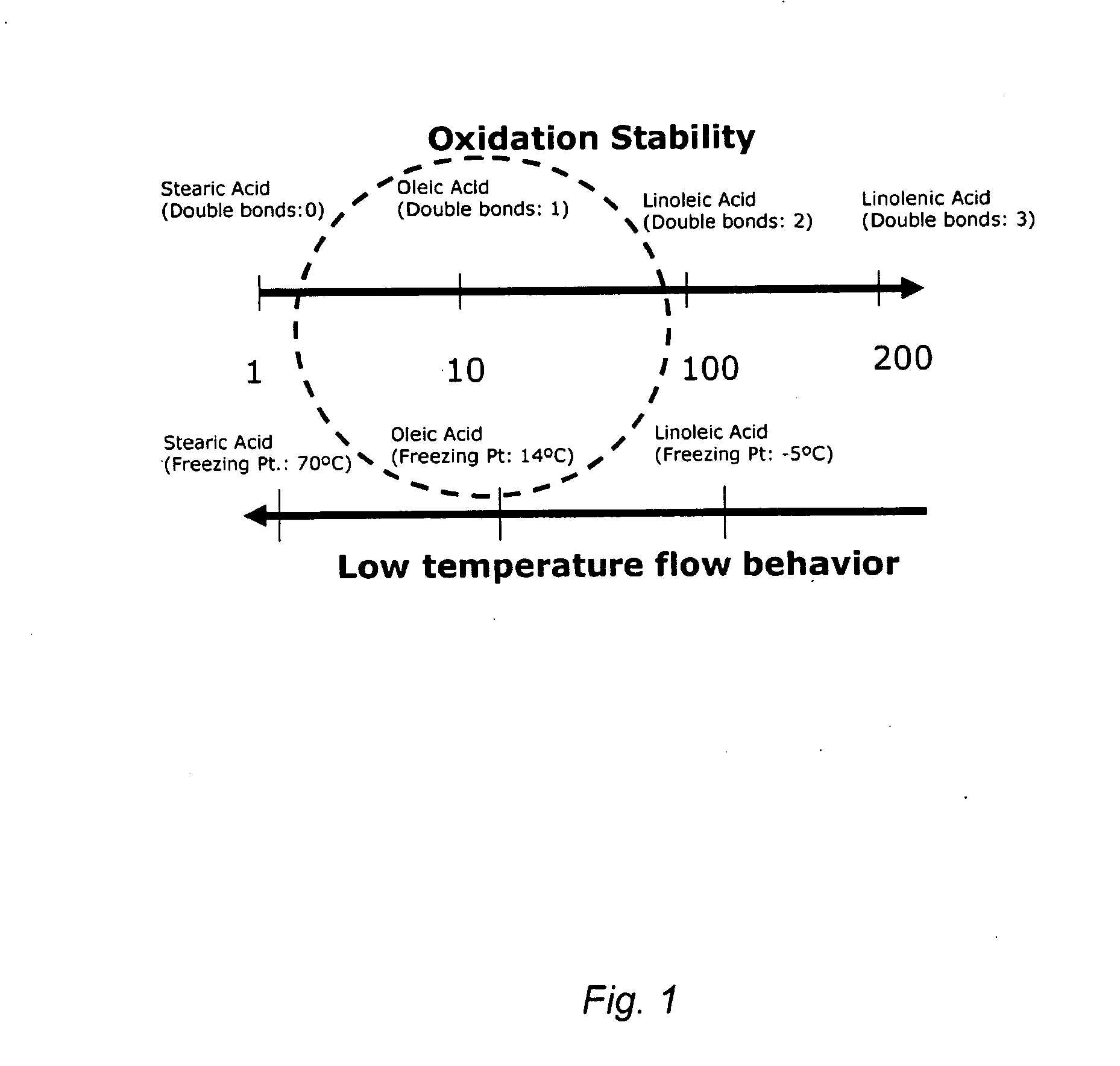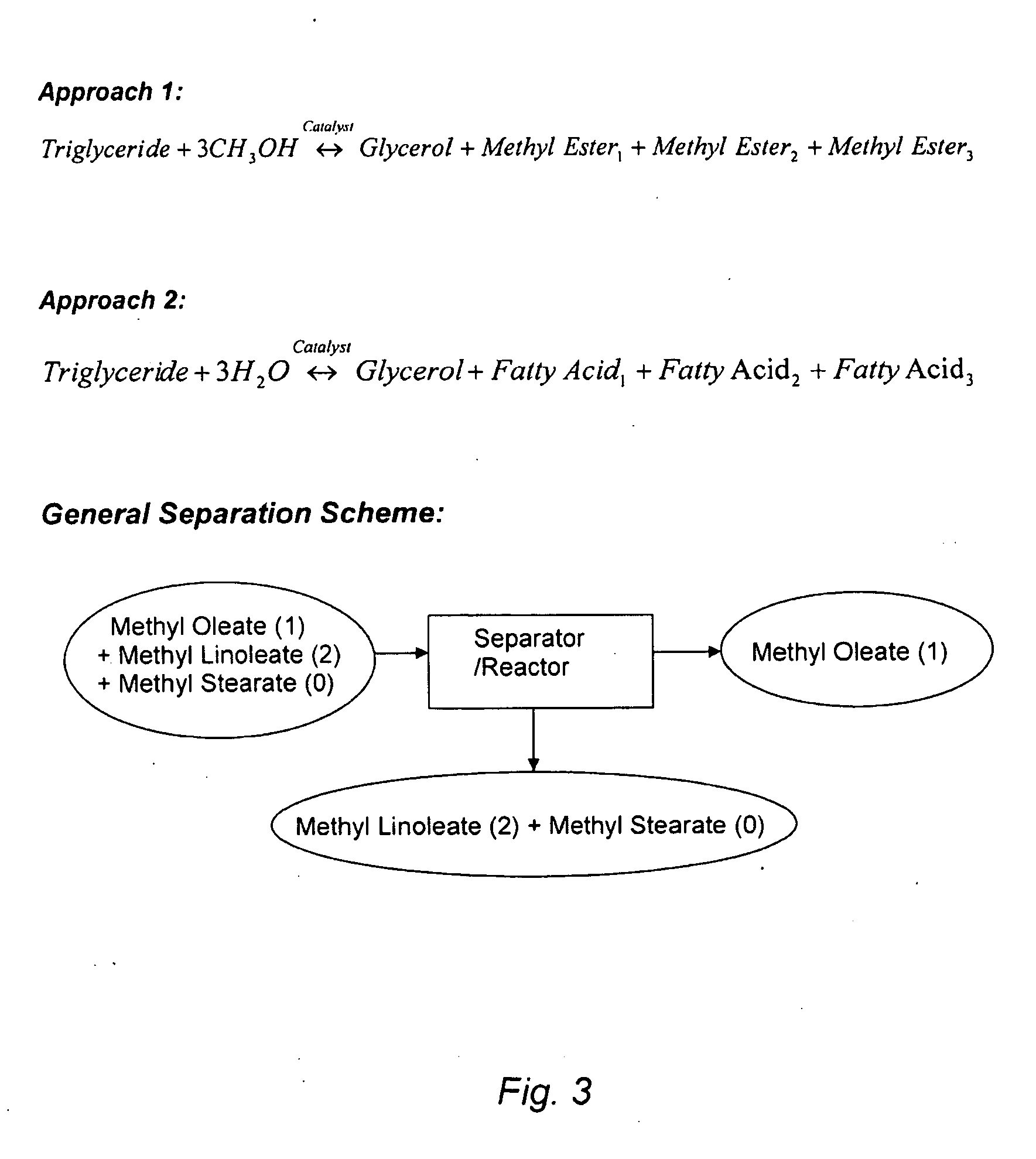Enrichment of monounsaturated acids/esters in vegetable oil- or animal fat-based feedstock using metal salts dissolved in ionic liquids
a technology of monounsaturated acids and esters, which is applied in the direction of fatty oil/acid recovery from waste, fatty oil/fat separation, fatty oil/fats refining, etc., can solve the problems of poor oxidation stability, contaminating soil and water, and generally poor oxidation stability
- Summary
- Abstract
- Description
- Claims
- Application Information
AI Technical Summary
Problems solved by technology
Method used
Image
Examples
example 1
[0069]This Example serves to illustrate, by way of a process flow diagram, an exemplary process for producing an oleic acid enriched product from a mixture of oleic acid (monounsaturated fatty acid) and linoleic acid (polyunsaturated fatty acid), in accordance with some embodiments of the present invention.
[0070]Referring to the process flow diagram of FIG. 7, in this example, a feed of 15,000 kg / day initial mixture of oleic acid and linoleic acid (70% oleic, 30% linoleic) is mixed with heptanes in extraction unit 701, and the resulting solution is treated with 1-butyl-3-methylimidazolium tetrafluoroborate (ionic liquid, [bmim][BF4]) containing 5% silver tetrafluoroborate (silver salt, AgBF4) by weight. After sufficient extraction time, the heptane phase (enriched in oleic acid relative to the initial mixture) is separated from the ionic liquid phase (enriched in linoleic acid relative to the initial mixture), and an oleic acid-enriched product is obtained by removing the heptanes i...
example 2
[0073]This Example serves to illustrate the effect of the Ag(I) salt concentration on the enrichment process for three initial mixtures having differing ratios of oleic:linoleic acid, in accordance with some embodiments of the present invention.
[0074]Referring to Table 3 (FIG. 8), in this example, mixtures of oleic acid and linoleic acid in different proportions (i.e., ratios) were prepared in heptane to generate feedstock solutions 1-3. Four grams of each feedstock solution was treated with 4 grams each of four different solutions of 1-butyl-3-methylimidazolium tetrafluoroborate ([bmim][BF4]) containing 5%, 10%, 15%, and 20% silver tetrafluoroborate (AgBF4) by weight, respectively. Table 3 shows the change in oleic and linoleic acid concentration of the heptane-fatty acid mixture before and after extraction / enrichment with each of the four Ag(I) salt solutions.
[0075]For the 5% Ag(I) salt case, FIG. 10 shows the enrichment in oleic acid during the extraction / enrichment process for e...
example 3
[0077]This Example serves to illustrate how average unsaturation number can be determined for lipid mixtures such as canola oil and palm oil.
[0078]Referring to Table 1 (FIG. 2), canola oil comprises 6 percent saturated free lipids (4% palmitic acid and 2% stearic—in a hydrolyzed state), 62 percent monounsaturated free lipids (oleic acid), 22 percent di-unsaturated free lipids (linoleic acid), and 10 percent tri-unsaturated free lipids (α-linoleic acid). Such a compositional mixture therefore can be said to have an average unsaturation number of 1.36, wherein there are 1.36 double bonds per molecule of the composition.
[0079]Referring again to Table 1, hydrolyzed palm oil comprises 50 percent saturated free lipids (as fatty acids), 40 percent monounsaturated free lipids, and 10 percent di-unsaturated free lipids. Accordingly, the average unsaturation number for the mixture is 0.6, meaning that there are 0.6 carbon-carbon double bonds per molecule in the compositional mixture.
6. Summar...
PUM
| Property | Measurement | Unit |
|---|---|---|
| pressure | aaaaa | aaaaa |
| pressures | aaaaa | aaaaa |
| pressures | aaaaa | aaaaa |
Abstract
Description
Claims
Application Information
 Login to view more
Login to view more - R&D Engineer
- R&D Manager
- IP Professional
- Industry Leading Data Capabilities
- Powerful AI technology
- Patent DNA Extraction
Browse by: Latest US Patents, China's latest patents, Technical Efficacy Thesaurus, Application Domain, Technology Topic.
© 2024 PatSnap. All rights reserved.Legal|Privacy policy|Modern Slavery Act Transparency Statement|Sitemap



